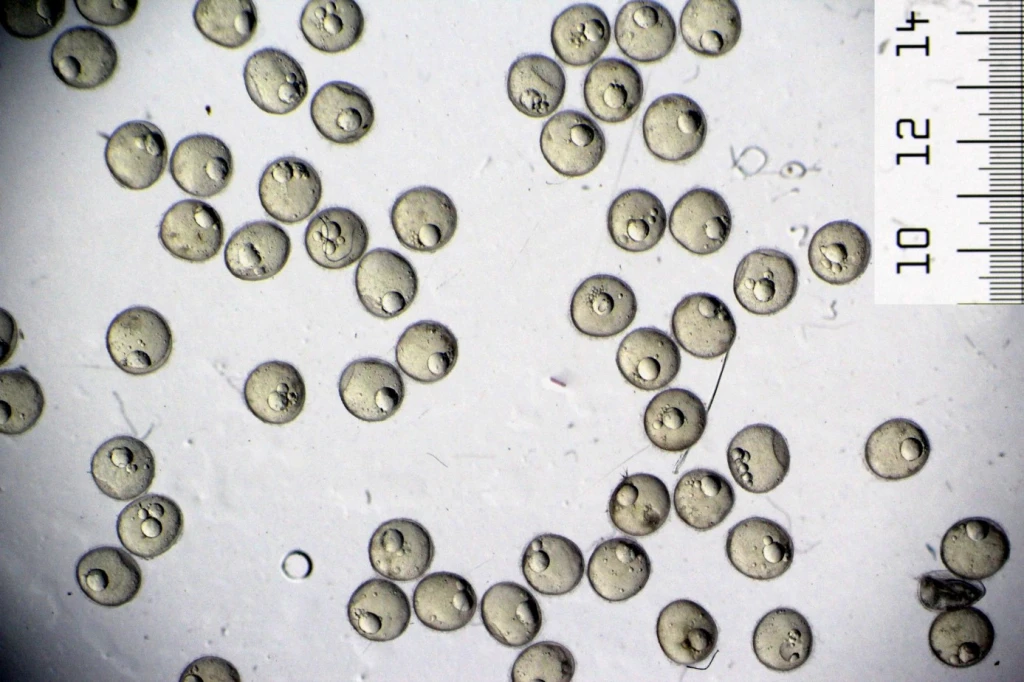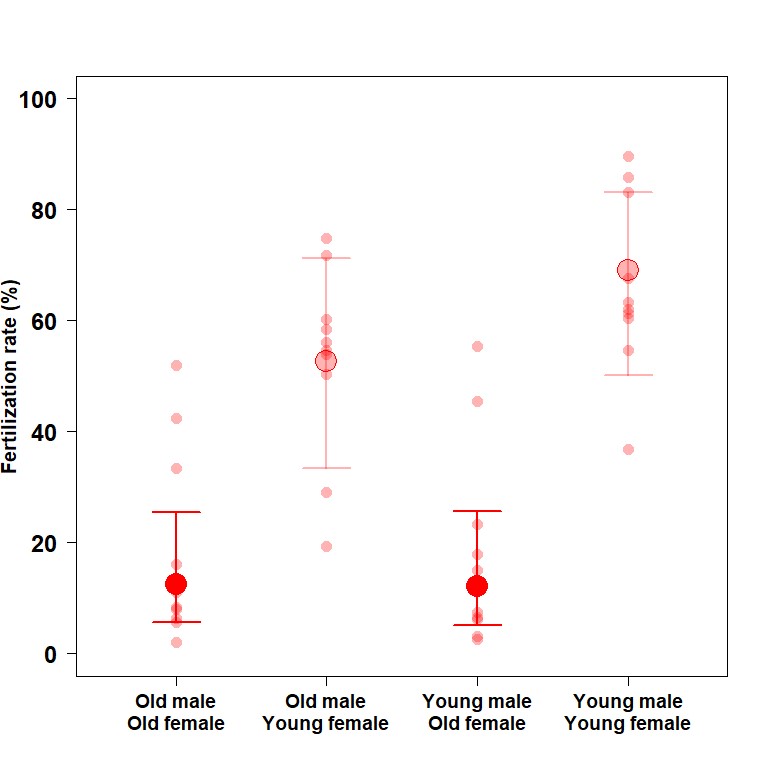This blog post is provided by Jakub Žák and Martin Reichard and tells their #StoryBehindthePaper for the article ‘Reproductive senescence in a short-lived fish’ which was recently published in Journal of Animal Ecology. Jakub Žák is a PhD candidate at Charles University, Czech Republic. He combines the field and laboratory approach to understand various aspects of ageing in short-lived annual killifish. Martin Reichard is senior scientist from the Institute of Vertebrate Biology, Czech Academy of Sciences. He uses fish to study ecological and evolutionary questions.
Reproductive senescence is a decline in reproductive function with advancing age, expressed as a decline in the number and quality of produced gametes, decrease in quality of sex-specific ornaments or by compromised offspring performance. Animals with indeterminate growth such as fish were assumed to not experience decline in reproductive function because their fecundity keeps rising as their body size increases. While this assumption is anchored in some evolutionary frameworks of aging, we demonstrate that short-lived killifish Nothobranchius furzeri experience clear reproductive senescence in a sex- and population-dependent manner.
Reproductive senescence is well understood in animals with determinate growth, such as most mammals, birds and insects, which stop growing at maturity. In contrast, we have very limited understanding of reproductive senescence in animals with an extensive post-maturity growth period, such as fish. Expected absence of reproductive senescence in fish with a long period of post-maturity growth is based on the assumption that the strength of natural selection does not fade after maturity. Their reproductive fitness increases with their body size, thus natural selection favours the large (and consequently old) individuals over the small (and young). Organisms with growth cessation at maturity have a low potential for age-related improvement in reproductive fitness and thus natural selection starts to decline after the first reproduction.
Short-lived fish, such as Nothobranchius furzeri, may provide clues into the evolution of reproductive senescence of organisms with a long period of post-maturity growth. Wild N. furzeri inhabit seasonally inundated savanna pools in south-east Africa, mature within two weeks and live only for a few months (Reichard & Polačik, 2019). Due to their short lifespan and easy breeding in the laboratory, they became a model organism for vertebrate aging (Cellerino, Valenzano, & Reichard, 2016; Hu & Brunet, 2018).
Our previous cross-sectional study measured reproductive senescence in wild Nothobranchius furzeri populations, but we did not find significant age-related decrease in the number of ovulated eggs in females (Vrtílek et al., 2018). Absence of observation of the reproductive senescence is common in the wild, especially when estimated cross-sectionally, with a single estimate for each individual. Cross-sectional estimates are prone to bias by selective disappearance of low-quality individuals, which may not live to old age. This may be overcome by repeated measurements of reproductive output in a specific set of individuals. In our study, we followed individual reproduction of more than 120 fish from two populations throughout their lifespan.
Nothobranchius furzeri populations (Figure 1) differed in the number of generations held in captive conditions, which helped us to disentangle potentially confounding effect of adaptation to laboratory conditions. The first was a laboratory population (GRZ, inbred, kept for 100 generations in captivity) and the second was a wild-type population (MZCS 222, outbred, kept for 7-9 generations in captivity).

Fish reproductive output was estimated every week throughout their lifespan (Figure 2), with the number of oocytes counted under a dissecting microscope.

We showed that the proportion of fertilized eggs declined relatively long after cessation of somatic growth (i.e. 6-9 weeks after growth cessation) in each population. We were curious if decline in fertilization capacity is related to lower egg quality or sperm quality. Thus, we cross-bred 8wo young individuals with 31wo old (senescent) experimental fish. To our surprise, the decline in ability to fertilize eggs was primarily related to decline in egg quality rather than fertilization capacity of males (Figure 3).

The decline in the number of produced eggs coincided with population-specific median survival which suggests association with somatic decline (Figure 4). Interestingly, in contrast to assumption of disposable soma theory of ageing (Kirkwood, 1977) and antagonistic pleiotropy theory (Williams, 1957), females which produced more eggs early in life lived longer.

Our study confirms that short-lived fish reach reproductive senescence when detailed individual data are available, though it is significantly postponed compared to animals with cessation of growth at maturity. This study also adds to the list of teleost fish species with confirmed reproductive senescence such as the Trinidadian guppy (Reznick, Bryant, Roff, Ghalambor, & Ghalambor, 2004) and the Atlantic herring (Benoît et al., 2018).
REFERENCES
Benoît, H. P., Swain, D. P., Hutchings, J. A., Knox, D., Doniol-Valcroze, T., & Bourne, C. M. (2018). Evidence for reproductive senescence in a broadly distributed harvested marine fish. Marine Ecology Progress Series, 592, 207–224.
Cellerino, A., Valenzano, D. R., & Reichard, M. (2016). From the bush to the bench: The annual Nothobranchius fishes as a new model system in biology. Biological Reviews, 91(2), 511–533. doi: 10.1111/brv.12183
Hu, C. K., & Brunet, A. (2018). The African turquoise killifish: A research organism to study vertebrate aging and diapause. Aging Cell, (February), 1–15. doi: 10.1111/acel.12757
Kirkwood, T. B. L. (1977). The evolution of aging. Nature, 270, 301–304.
Reichard, M., & Polačik, M. (2019). Nothobranchius furzeri, an ’instant’ fish from an ephemeral habitat. ELife, 8, e41548. doi: 10.6084/m9.fig-share.7017167
Reznick, D. N., Bryant, M. lJ., Roff, D., Ghalambor, C. K., & Ghalambor, D. E. (2004). Effect of extrinsic mortality on the evolution of senescence in guppies. Nature, 431(7012), 1095–1099. doi: 10.1038/nature02936
Vrtílek, M., Žák, J., Blažek, R., Polačik, M., Cellerino, A., & Reichard, M. (2018). Limited scope for reproductive senescence in wild populations of a short-lived fish. The Science of Nature, 105(68). doi: 10.1007/s00114-018-1594-5
Williams, G. C. (1957). Pleiotropy, natural selection and the evolution of senescence. Evolution, 11(4), 398–411.
